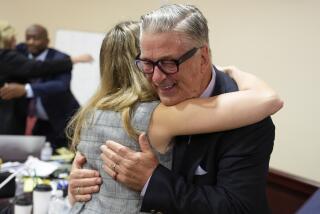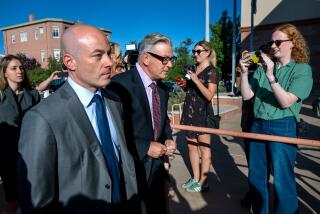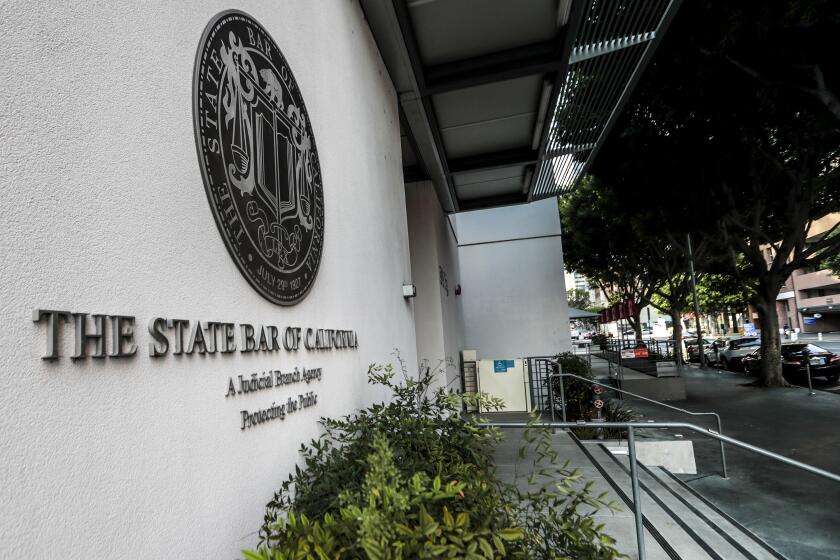Jury Rapt as Simpson Tries Bloody Gloves
- Share via
In a gripping scene that transfixed jurors Thursday afternoon, O.J. Simpson worked his hands into the pair of frayed, bloodied leather gloves that prosecutors say he wore to murder Nicole Brown Simpson and Ronald Lyle Goldman--and pronounced them “Too tight.”
The surprise demonstration, in which Simpson sought to show the jury how tough it was to squeeze into the gloves, was widely perceived as a blow to the government’s case against the former football star.
Although prosecutors asked Simpson to try on the gloves, it was the defense team that emerged smiling after the dramatic display--a moment of live human drama that followed more than a week of gory autopsy photos and numbing charts presented by the Los Angeles County coroner.
“Obviously the prosecution was hoping for the perfect Cinderella ending,” Southwestern University law professor Karen Smith said. But jurors could interpret the tight fit, she said, as a suggestion that “those weren’t his gloves.” On the other hand, Smith added, “certainly the gloves fit to some degree; it wasn’t as if they didn’t fit at all.”
The theatrical episode began when, after a brief sidebar conference with defense lawyers, prosecutors handed Simpson the worn brown gloves--one of them with a bloodstain circled in silver ink.
Looking relaxed and confident, Simpson pulled two latex gloves out of a box in front of him and yanked them over his hands. Then he carefully picked up the cashmere-lined leather gloves and tried to tug them on--raising his eyebrows, pursing his lips and using other body language to convey difficulty.
The Aris Isotoner gloves are designed to be snug. In fact, a prosecution witness had testified earlier in the day that customers favored the gloves because they fit almost like a second skin. But Simpson, shaking his head and grinning with an expression of incredulity, showed the jurors that he could not fully extend his fingers into the tips of the gloves.
Raising his hands in front of him and flexing his fingers, he revealed that the extra-large gloves did not stretch all the way to his wrists.
Darden meanwhile provided a running commentary about Simpson’s glove-donning technique, and even asked Judge Lance A. Ito to instruct Simpson to put the gloves on in a normal manner. Later, in a question to a witness, he implied that Simpson had been bending his thumb so the glove would not slip on easily.
Simpson jumped in himself, commenting, “Too tight,” as he faced the jury.
Fascinated, the jurors leaned forward and craned their necks. Their faces betrayed neither surprise nor excitement, but they were clearly spellbound by the show.
At the prosecution’s direction, Simpson then grasped a large blue marking pen in his right fist. Darden asked him to move his arm, apparently to simulate a knife thrust, but Ito halted the demonstration when the defense objected.
The jurors scribbled notes frantically. At least three continued jotting their impressions for several minutes after Simpson handed the bloody gloves to Darden and returned to his seat. Leaning back with an air of satisfaction, Simpson whipped off the latex liners and tossed them jauntily onto the table.
Darden quickly tried to recoup.
Seeking to dull the impact of the display, Darden asked witness Richard Rubin, the former general manager of the glove manufacturer Aris, whether an extra-large glove should fit Simpson’s hand.
Simpson congenially held out both hands for inspection. Rubin studied them, even holding Simpson’s clenched fist for a moment. “At one point in time, those gloves would actually be large, I think, on Mr. Simpson’s hand,” he testified.
Darden did not ask Rubin whether moisture--such as blood or dew--could shrink the gloves. And Rubin said he did not feel qualified to testify about whether the latex gloves Simpson was wearing could have contributed to the tightness of the fit.
Legal observers noted several reasons why the bloody gloves might not have fit Simpson: They could have shrunk because of moisture, or become misshapen after months of storage, or simply not be designed to glide on over latex. But they added that the sheer drama of the scene, in which Simpson once again had a chance to interact directly with the jury, might have dealt a serious blow to the prosecution’s case.
“It was a gamble for them to do it,” Smith said. “It was not the ending they would have wanted.”
The bloody gloves, from the beginning a compelling symbol of the crime, have taken on huge significance over the past six months.
Prosecutors contend that Simpson dropped the right glove at the murder scene in his haste, then let its mate fall on his property as he was dashing home. The gloves form a critical part of the “trail of blood” that they contend Simpson left at both the Bundy Drive crime scene and his Rockingham Avenue estate.
But to the defense team, the gloves have become a stand-in for police incompetence or corruption. Defense lawyers have argued that a Los Angeles police detective could have planted a glove at Simpson’s estate in a frenzy to convict the former star athlete.
A Lively Day of Testimony
Coming just moments before adjournment, Simpson’s glove demonstration capped a fast-paced day that started with clinical forensic testimony, featuring a graphic display of stabbing techniques by defense attorney Robert Shapiro.
With no eyewitnesses to the crime, prosecutors have relied on Los Angeles County Coroner Lakshmanan Sathyavagiswaran’s forensic testimony to bolster their hypothesis that Simpson surprised both victims, rapidly overpowered them and knifed them to death within minutes.
On cross-examination, however, Sathyavagiswaran acknowledged that he could not with “medical certainty” determine how many assailants attacked Nicole Simpson and Goldman.
To press the point, Shapiro then grabbed a knife for a startling courtroom demonstration of the many ways to lunge at and stab a victim. As Shapiro, an amateur boxer, slashed the air with his glinting, single-edged blade, he rattled off a list of the various grips and motions he was using. Demonstrating that an agile assailant could kill a victim any number of ways, Shapiro elicited Sathyavagiswaran’s admission that it was difficult to figure out even such basic information as whether a murderer was right- or left-handed.
Under Shapiro’s intense questioning, Sathyavagiswaran acknowledged that he based all his conclusions on autopsy photographs and notes, not on detailed firsthand examination of the bodies. The record he relied on was compiled by Dr. Irwin Golden--the same pathologist who made more than two dozen mistakes when he performed the autopsies.
Sathyavagiswaran insisted that he had confidence in Golden’s photographs and notes, despite the many errors.
“So you’re saying a photograph is a substitute for an in-person autopsy?” Shapiro asked.
“That’s not my opinion,” the coroner answered.
“But that’s what you’re going on?” Shapiro pressed.
“Under the circumstances, yes.”
Shapiro also questioned Sathyavagiswaran’s opinion that Goldman flailed at his assailant with open hands, but did not land a firm punch.
The jury has already seen a photograph of Simpson, taken shortly after the murders, which showed no obvious injuries, except for a cut on one hand. In an incredulous tone, Shapiro asked whether it was plausible that a healthy, athletic young man such as Goldman could have succumbed without inflicting more wounds on his attacker.
If Goldman were incapacitated quickly, “you may not see injuries on the attacker,” Sathyavagiswaran answered.
Backing up slowly with his arms open wide, exposing his chest and face, Shapiro asked whether Sathyavagiswaran really believed Goldman would have faced an assailant in such a vulnerable position, instead of crouching or protecting his head.
The question gave Sathyavagiswaran a chance to recap, with one powerful sentence, just how brutal the attack on Goldman was. In his terror, the coroner testified, Goldman might have tried to squirm away, rather than lash out at a knife-wielding aggressor.
“He backed, he ducked, he turned, he twisted and he didn’t have a chance,” Sathyavagiswaran said.
Striking back, Shapiro reminded both the witness and the jury that such descriptions are speculative.
“Neither you nor any other medical examiner can accurately reconstruct what took place?” Shapiro asked the soft-spoken coroner.
“Accurately reconstruct?” Sathyavagiswaran repeated. “No.”
Later, Deputy Dist. Atty. Brian Kelberg sought to re-establish the prosecution theory as the most credible of myriad possible crime-scene reconstructions.
“Would you stake your reputation that the evidence is consistent with these murders having been performed by a single perpetrator 6 foot, 2 inches tall, 210 pounds, athletically built, with an element of surprise and a six-inch knife?” Kelberg asked, his voice rising dramatically.
After a brief exchange, Sathyavagiswaran answered quietly, “Yes.”
New Witnesses Emerge
Outside court, prosecutors announced that they hope to call two new witnesses to testify about Simpson’s alleged abuse of his ex-wife.
Meanwhile, defense attorneys filed a motion to put all jury investigations on hold until after closing arguments. And one woman who had been in the jury pool but was not impaneled filed a declaration claiming that two sheriff’s deputies told her the Los Angeles Police Department was investigating Simpson jurors.
Prosecutors said Gioconda Redfern, who used to baby-sit for Nicole Simpson, will testify that her boss “was in constant fear” of O.J. Simpson, who often complained about her behavior and attire. Simpson repeatedly tried to check up on his ex-wife’s whereabouts--once calling 50 times in two hours, Redfern said.
Such behavior, prosecutors argue, shows that O.J. Simpson may have obsessively stalked his ex-wife in a violent relationship that ultimately ended in murder.
The second witness will testify that she saw O.J. Simpson shove Nicole Simpson against a Bentley parked in the driveway of his Rockingham Avenue estate. Elizabeth Holmes, a personal trainer who worked for Simpson’s neighbors, “heard a loud thud when Nicole Brown Simpson struck the car,” according to the prosecution’s motion.
Ito has not announced when he will consider the prosecution’s motion to call Redfern and Holmes.
“In any issue like this, the judge has to do a balancing act in terms of how relevant the testimony is against any unfair prejudicial impact it might have,” Loyola law professor Laurie Levenson said.
Gloves Take Center Stage
Before the glove demonstration, the afternoon seemed to be going reasonably well for the prosecution.
Bloomingdale’s buyer Brenda Vemich identified a charge-card receipt, signed by Nicole Brown, for the $77 purchase of two pairs of Aris Isotoner gloves.
She testified that the gloves Nicole Simpson bought on December 18, 1990, were called Aris Isotoner leather lights--the same expensive style, she said, as the gloves found at the crime scene and at Simpson’s estate.
But on cross-examination, Vemich acknowledged that she could not tell from the receipt what size or color gloves Nicole Simpson had purchased.
In a relaxed, jovial manner, Cochran himself tried on the glove found at Simpson’s estate to ask Vemich about its size. Stretching out his hand, he tried to tug the torn leather down over his wrist--in a gesture Simpson would later mimic. He then asked her whether the glove was really an extra large.
“Yes, it is, but it doesn’t fit you,” Vemich said.
“Right, it’s small,” Cochran said.
“It’s too big,” Vemich instantly contradicted him.
“Since I’m wearing it, it seems too small, but we won’t argue about that,” Cochran responded. That exchange, little more than a lighthearted aside at the time, illustrated the difficulty inherent in determining a glove’s fit.
After Cochran had finished his gentle cross-examination, the prosecution called Rubin.
A chatty, relaxed witness, Rubin acknowledged that he could not determine the year in which the crime-scene glove was purchased. Aris manufactured thousands of pairs of similar gloves between 1982 and 1992 and Bloomingdale’s had an exclusive contract to sell them.
Of the 10,000 pairs of gloves the company manufactured in 1990, he said, about 300 were extra-large brown gloves of the type linked to the murder scene. Fewer than 240 pairs were sold, he said.
With court scheduled to end an hour early so a juror could see a doctor, it looked as if the testimony might end there. But moments later, Darden asked Simpson to don the glove.
“They couldn’t ask Simpson to do a dress rehearsal,” law professor Smith noted. “It was a one-time shot.”
Times staff writers Andrea Ford and Henry Weinstein contributed to this story.
More to Read
Sign up for Essential California
The most important California stories and recommendations in your inbox every morning.
You may occasionally receive promotional content from the Los Angeles Times.










